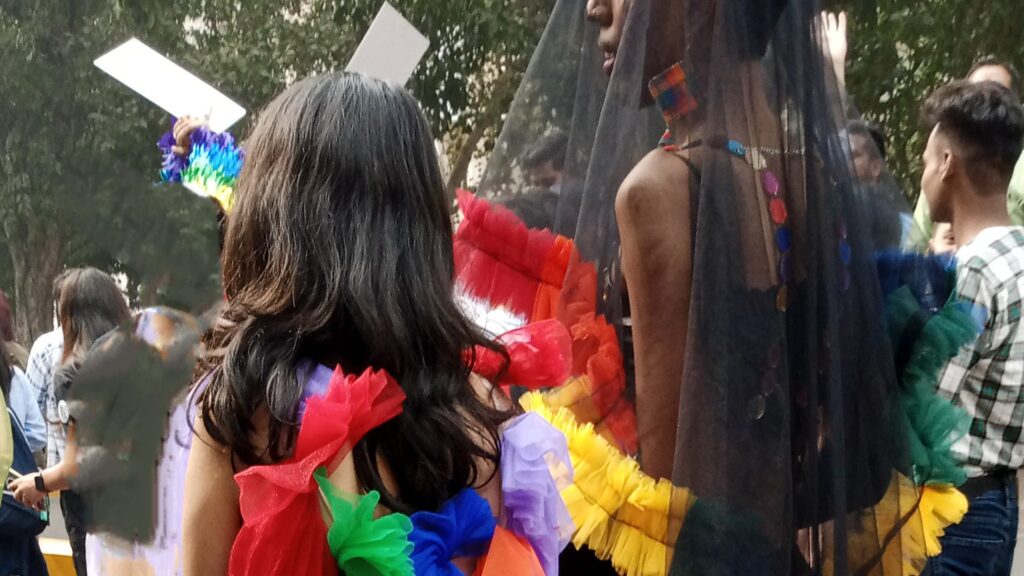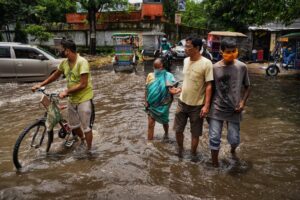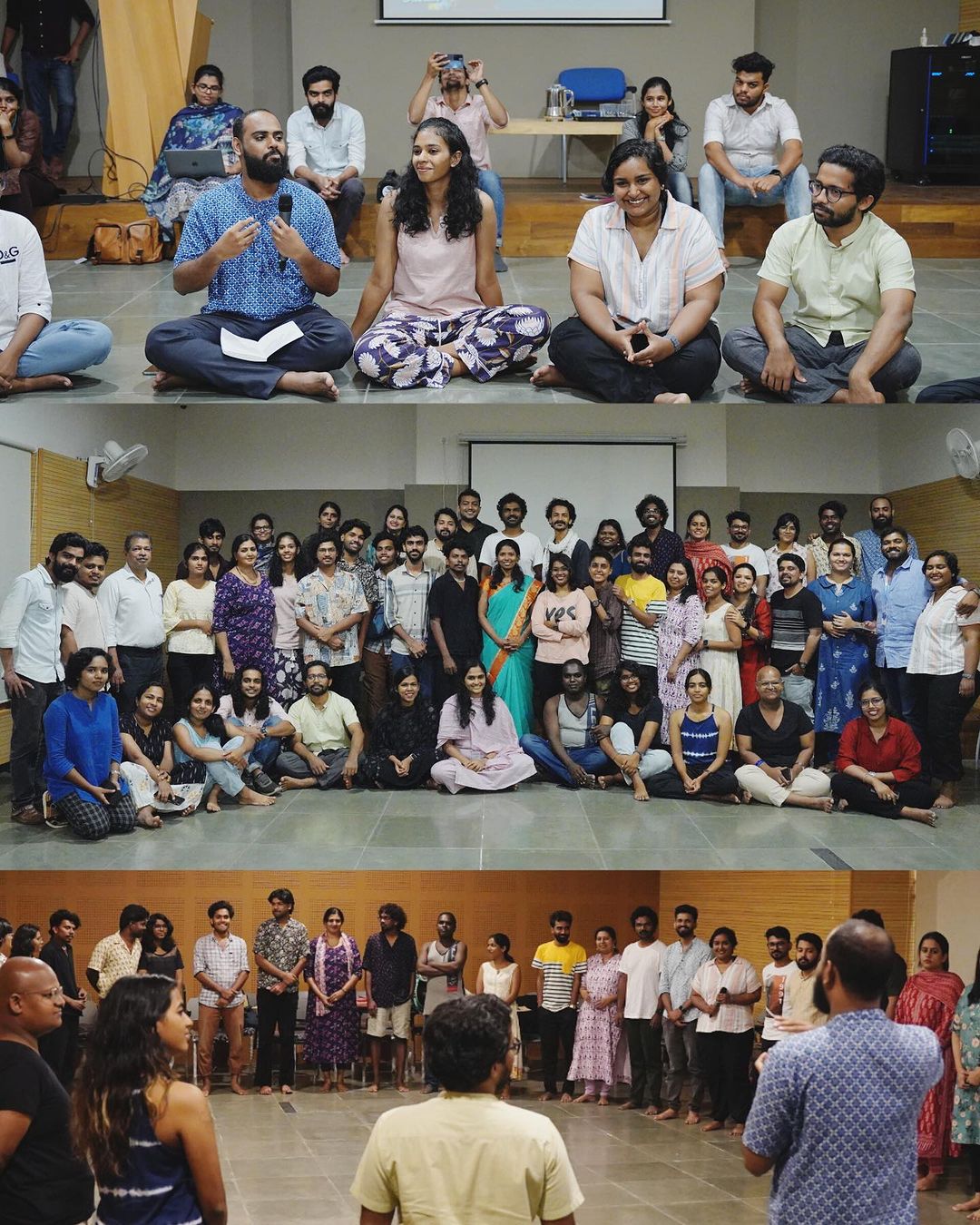
Representational image/ Sahil Pradhan
Cyclone Michaung recently battered Chennai, leaving several dead. The effects of devastating rainfall and waterlogging impacted lives across the city, but one especially vulnerable group was the city’s queer population.
“The cyclone has affected the trans community, especially trans women, the most. Many community members depend on begging and sex work for a living, so when a natural disaster happens, and people are unable to step out or go about their daily life, it impacts the trans community even more,” says Sudha, technical advisor, Sahodaran, a Chennai-based male sexual health project, adding that the trans community is particularly vulnerable to the adverse effects of climate change.
Community members are still recovering from the aftermath of the cyclone, says Sudha. “In Arumbakkam, 15 trans women who are living together lost all their belongings due to the floods. Near Koyambedu Circle, 25 trans women living together also lost all their possessions. Now they have to buy everything from scratch,” she says.
The TN government announced Rs 6,000 to each flood-affected family. “Some trans people do not have ration cards so they could not avail of it. Also, among the younger ones, many haven’t changed their name on the Aadhaar or are in the process of getting it changed, so they have been unable to avail of the benefits. We have got good healthcare thanks to government initiatives,” says Sudha.
While extreme weather events like Chennai’s floods highlight the climate vulnerability of marginalised groups, accelerating climate change threatens to intensify existing inequities across India. Queer individuals disproportionately face housing, employment and healthcare precarity, putting them on the frontlines of a warming world.
According to the rough estimates of a 2012 UNDP-India study, Chennai is home to around 30,000 queer people, many of whom live hand-to-mouth existences ostracised from mainstream Indian society. Most of them work unstable jobs in the unorganised sector, lack family support networks, and reside in unauthorised slum dwellings prone to weather damages. For them, losing employment and housing in the floods was catastrophic.
“We had nowhere to go,” recalls Kanni, a trans woman who lost her home and job as a domestic worker in the floods. “People didn’t want to give shelter to people like us.” She says, recalling the floods of 2015 when she ended up begging on the streets for weeks before aid agencies were able to provide temporary housing.
Livelihoods on the line
According to the first-ever study on the rights of transgender people by the National Human Rights Commission, published in 2018, about 92% of the transgender population is deprived of the right to participate in any form of economic activity in the country. Even the qualified are refused jobs. Most end up working unstable jobs in the informal sector — as street vendors, waste pickers, domestic helpers or daily wage labourers.
These occupations provide little income, security or protection. They are highly climate-sensitive: extreme heat disrupts outdoor work, floods and storms destroy insecure assets, and droughts increase water insecurity and the threat of infectious diseases.
During recent heat waves in Odisha, according to a queer collective here, many queer individuals living in tin sheds or on the streets suffered heat strokes, dehydration, and breathing problems. In floods, many lose their life’s earnings overnight. In the 2019 Assam Floods, according to the All Assam Transgender Association (AATA), at least 13 gharanas or traditional housing for trans groups, each comprising 60 to 70 people, were washed away. Such climate shocks force many into exploitative work just to repay debts and survive.
“We are already teetering on the margins,” says Vinay, a gay man in Odisha, who does sex work when he can’t find other jobs. “Whether it’s a storm or water shortage, it pushes us over the edge.”
Battling homelessness
Affordable housing is another major challenge. A significant number of queer individuals lack family support, and face discrimination in the housing market, throwing many into homelessness.
Due to the unavailability of accommodation and discrimination in housing, around 53% of transgenders live under the guru-chela system according to the NHRC study, where gurus (seniors in the transgender community) take care of their shelter in place of a cut in their incomes. Most inhabited unauthorized slum dwellings are prone to climate hazards like storms, floods, and heat waves.
“In Chennai, many trans people live near the Cooum River and also in housing board tenements and slum areas, all of which were badly affected by the floods. Trans people usually live in large groups so when even one house is flooded, many people suffer,” says Sudha, recounting the effects of the 2023 Chennai floods.

Representational image Picture credit: Unsplash
The 2018 NHRC study finds that 99% of transgender people have suffered social rejection on more than one occasion. On their education, NHRC says 52% transgenders were harassed by their classmates and 15% by even teachers, a reason why they don’t continue their studies. In an environment as such most are invisible to the establishment and incumbent powers for the provision of proper relief.
During disasters, many are denied refuge in public shelters and relief camps due to fear of harassment and attack. Indu, a trans woman in Odisha, recalls how she was beaten and not given any relief materials for weeks in the relief camp after the Fani cyclone. “They threw away the food packets that I touched, and called me filthy names. Just because there were police they couldn’t throw me out of the shelter or they would have done that,” she says. This housing precarity amplifies climate vulnerability — homeless queer populations disproportionately suffer weather-related health issues while lacking resources to bounce back after climate shocks.
Like other marginalised Indian communities, queer groups have been systematically excluded from early warning systems and disaster preparations tailored to middle-class or lower-income families. Sexual minorities have historically suffered from mainstream prejudice, and the pandemic has aggravated socio-economic inequalities, and instigated family and institutionalised abuse, apart from limiting access to essential care. Thus, despite their heightened climate vulnerability, they shoulder an unequal share of human losses.
Overlooking risks to queer citizens results in a glaring preparedness gap. But empowering and collaborating with queer organisations could fill this gap during extremes.
“We know our communities best, and how to reach those most at risk,” says an employee at a queer rights group. “With funding and training, we could disseminate alerts and resources to prevent needless casualties.”
Healthcare barriers
Inadequate healthcare access further compounds climate threats. The majority of queer individuals lack access to physical and mental healthcare vital for coping with climate stresses.
Healthcare discrimination and unaffordability have life-threatening implications during climate shocks. Many are reluctant to seek medical attention during disasters and weather extremes due to past abuse by healthcare workers.
A SAGE study published in 2020 that analysed mental health data for LGBTQIA+ individuals in India from 2009 to 2019 mentions how individuals belonging to gender minorities typically have higher prevalence rates of mental illness. About 70% of men who have sex with men, and 90% transgender population in India face depression, frequent alcohol use, and victimisation due to gender-based violence.
Studies have also found queer, particularly trans, populations suffer higher rates of anxiety, depression, and post-traumatic stress disorder following climate events — health issues aggravated by inadequate mental health support.
Pathways to resilience
Beyond disaster response, enabling equitable climate resilience requires addressing root inequities. Income protection, housing, and healthcare must be made accessible for marginalised groups already living in precarious existences.
Queer organisations recommend funding skills training and employment assistance; making affordable housing and shelters inclusive; expanding access to physical and mental healthcare; and embedding queer voices in policymaking.
“We need long-term solutions to build real resilience,” says Ananya, a queer climate rights activist. “Or we risk losing more lives and erasing more stories with each passing storm.”



